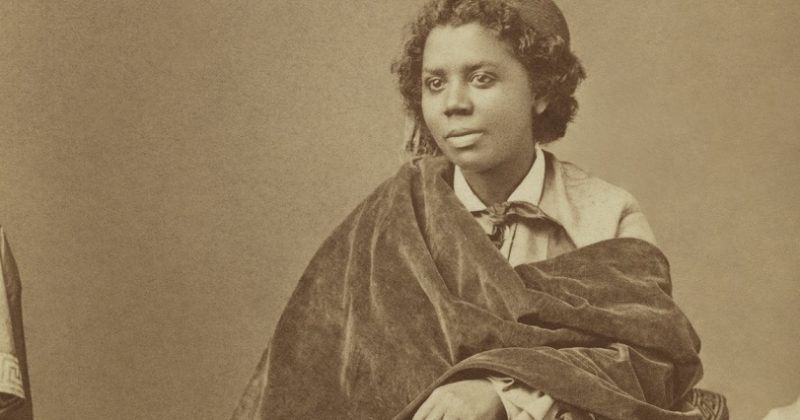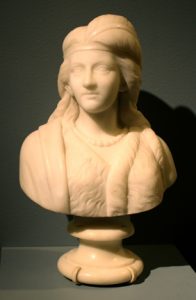Susan O'Rourke | February 14, 2022

UNC World View looks forward to celebrating Women’s History Month in March by reflecting on the global influence on and impact of women in the arts. Whether they studied the works of international artists, traveled abroad for training, or emphasized how “global is local” through the fusion of their global and American heritages, many women in the arts exemplify the power of a global mindset. Their global perspectives allow them to discover new information and reflect on their own identities and communities.
One such artist is the American sculptor Edmonia Lewis, who recently was commemorated by the United States Postal Service on their “45th

stamp in the Black Heritage series.” Lewis, the Smithsonian Institute notes, “was the first sculptor of African American and Native American (Mississauga) descent to achieve international recognition.” Lewis was a student at Oberlin College for a period of time before moving to Boston and later to Rome, where she was “involved with a group of American women sculptors.” Lewis’s work while in Rome included “marble neoclassical sculpture that often incorporated African American and Native American subjects” as well as “religious sculptures,” some of which were featured in “churches in Baltimore and Scotland.” Lewis’s work represents the power art has to tie together local and global cultures and lived experiences.
We encourage educators to talk about the important legacies of such influential artists during Women’s History Month.
Additional American artists that you might feature in classroom discussions include:
- Marguerite Zorach (1887-1968), a painter, weaver, and graphic artist whose work was influenced by the Fauves and her colleagues Pablo Picasso and Gertrude Stein
- Augusta Savage (1892-1962), a sculptor, art teacher, and community art program director who was the first African-American member of the National Association of Women Painters and Sculptors and who traveled throughout France, Belgium, and Germany after winning prestigious fellowships and funding from the Carnegie Foundation
- Berenice Abbott (1898-1991), a photographer deeply influenced by her time in France and by the work of French photographer Eugene Atget
- Kay Sekimachi (1926–), a fiber artist and weaver, influenced by antique Japanese paper and “recognized as a pioneer in resurrecting [fiber] as a medium of artistic expression”
- Joyce Scott (1948–) a jewelry maker and sculptor who “identifies African American, Native American, and West African Yoruba beadwork as primary influences… [but also] emphasizes that her work refers to cultures around the globe, stating that ‘If we are going to work things out, we have to work together.’”
- Consuelo Jiménez Underwood (1949–), “a fiber artist and weaver… [who] has degrees in religious studies and art…[and] imbues her pieces with powerful messages about her Chicana heritage.”
Educators may also consider using the resources below from the National Museum of Women in the Arts to facilitate those discussions. We hope that the lives of these extraordinary artists will help inspire your students to think about the power of artistic study and practice to both open windows to the world and bring local culture to the world stage.
We also encourage educators interested in learning about the impact of women writers in Renaissance England to sign up for our March 8th virtual program, “Write-Minded Women: The Scientific, Poetic, and Philosophical Writing of Women in Renaissance England.” During this program, we’ll meet some remarkable women left behind by history and share resources for bringing them back to classrooms!
National Museum of Women in the Arts: Exhibition and Collection Educator Guides:
- Arts, Books, and Creativity (ABC) Curriculum
- The bilingual Art, Books, and Creativity (ABC) curriculum consists of 14 lessons, which combine visual arts and writing activities. ABC introduces students to artworks by women, as well as basic art vocabulary and concepts. It leads students through the process of creating artists’ books in a range of book formats and culminates with a classroom exhibition and critique of students’ works. Designed for use in 4th- and 5th-grade classrooms, the curriculum can be differentiated for other grade levels.
- Picturing Mary: Woman, Mother, Idea
- “Picturing Mary primarily explores the visual language developed in Renaissance and Baroque Italy to represent the Virgin Mary and her child. While the works in this exhibition were intended for religious use, at their core they provide insight into the universal and timeless concepts of unconditional love, grief, and hope. The works included in this resource are but a fragment of a centuries-old and continuing tradition of expressing these concepts visually.”
- American People, Black Light: Faith Ringgold’s Paintings of the 1960s
- Faith Ringgold (b. 1930) is well known for originating the African American story quilt revival in the late 1970s. In the previous decade, she created bold, provocative paintings in direct response to the Civil Rights and feminist movements. Ringgold’s unprecedented exploration of race and gender in America is examined in this comprehensive survey of 49 rarely-exhibited paintings.
- The educator guide includes digital images, worksheets and classroom activities, discussion questions, and a glossary.
Virtual Galleries for Elementary Audiences
Virtual Galleries for All Ages
